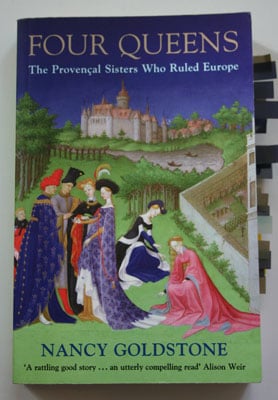Book Review: Four Queens
Posted on
As part of my eBook research, and because I enjoy reading about other areas of history, I buy and read quite a lot of history books. One of the best ones I’ve read this year is “Four Queens: The Provencal Sisters Who Ruled Europe” by Nancy Goldstone (please excuse the research tabs I've had to stick in the book, it's proved to be very useful XD)

I’ve read some of Goldstone’s works before, one of the main ones being “Joanna: The Notorious Queen of Naples”. That was a book I found a hard slog to go through, partly because Joanna faced a lot of problems during her reign and so the book was very large, partly because it just seemed like the writing was a bit difficult to get through. Naturally I was worried that Four Queens would be the same, but luckily it wasn’t.
Four Queens tells the story of the daughters of Raymond Berenger, the Count of Provence, and his wife Beatrice of Savoy. They had four daughters and no sons, and one by one their daughters married into two of Europe’s leading families. Their eldest daughter Margaret became Queen of France, Eleanor (the second daughter) married King Henry III of England, Sanchia married Henry’s brother Richard Earl of Cornwall, and the youngest sister Beatrice married Margaret’s brother-in-law the Count of Anjou and also inherited Provence from their father.
Normally English history only focuses on Eleanor of Provence since she and Henry faced rebellion during their reign. But as this book shows, these sisters all had interesting lives. Margaret and Beatrice both went on Crusade with their husbands and Beatrice went with her husband when he conquered Sicily, while Sanchia followed Richard to the continent when he became King of the Germans. Thanks to the efforts of Margaret and Eleanor, England and France spent a great deal of time at peace, rather than constantly fighting between each other.
This book starts off with the girls’ childhood in Provence and follows each one chapter by chapter. Generally Goldstone tries to focus one chapter on each woman, but there are points where even though a chapter is focusing on one woman, one or two of her sisters will get a prominent role as well, simply because they spent time together. This alternating between women actually makes the book easier to read without becoming too confusing, it also gives plenty of stopping-off places if you’re reading during lunch or tea break and need to put it down.
Goldstone also does her best to make sure the book actually focuses on the women themselves. There are many history books, even those that are meant to be about women in history, that focus purely on kings. While the husbands are mentioned frequently to explain the historical context, Goldstone then ensures that she explains the women’s side of things, postulating theories on their feelings and reactions. It helps that her research has included letters between Margaret and Eleanor, which give a more personal flavour about the relationship between the two queens (even though the letters were probably dictated to clerks by the queens themselves).
If there is one complaint I have about this book, it’s that there is a presumption towards understanding or second-guessing the thoughts of the women involved. But this may simply be due to the evidence Goldstone has used, I imagine that reading letters and personal accounts gives a far more intimate glimpse into the lives than simply summing them up does.
Overall I think this is a really good book, I’d highly recommend it to anyone who wants to know more about Eleanor of Provence, and especially anyone who wants to know more about upper-class women in Medieval Europe.